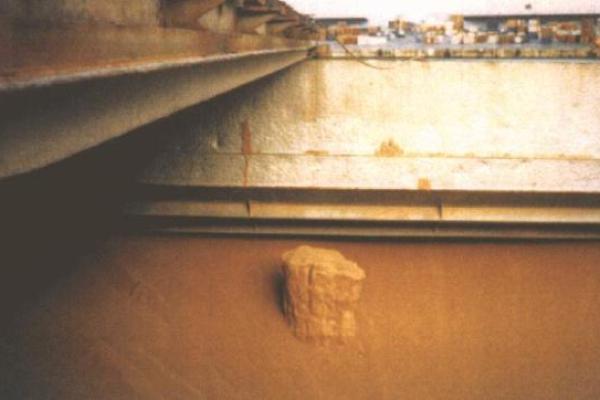
Steamship Mutual
Published: April 01, 2013
Many commodities can become damaged by water onboard ship. This can take many forms but the most common involve either ingress of water from an external source (sea water or rain water) or movement of moisture within the hold leading to condensation. Often more than one of these mechanisms may be in place and it becomes important to understand what processes cause which phenomena and which is likely to be more significant. The focus of this article will be on agricultural-type commodities such as grain and animal feedstuffs, but some of the principles will apply equally to other cargoes.
When a vessel arrives at discharge, it is commonplace for an inspection to take place of the surface of the stows. If sea water has entered the hold through leaking hatch covers, that should be evident from the surface. It is however often difficult to assess the severity of wetting from the surface. This becomes more apparent later during discharge.
Condensation (ship’s sweat) wetting of bulk cargoes is essentially a surface phenomenon and rarely penetrates more than a few centimetres into a stow. It happens when the steelwork is cooled by external conditions leading to moisture deposition on the cold steel.
Moisture migration – causes and effects
Moisture migration is a more complex phenomenon and is usually caused by temperature differences. Moisture tends to move from warmer cargo into cooler parts of the stow. Large movements of moisture only take place when there are large temperature differences affecting large areas. Usually moisture migration involves moisture being driven upwards in the stow by warm cargo.
It is important therefore to see moisture migration as the consequence of a temperature gradient, not an actual mechanism causing damage in its own right. Many attribute damage associated with caking or mouldiness to “moisture migration” without actually considering what has caused the moisture movement.
In some cases, cargo can become cooled by external conditions, and this may result in moisture migrating to that cooler cargo which then deteriorates. This only affects cargo at or very near the periphery of a stow.
More usually, moisture migration is caused when cargo becomes warmed. This can take place by heat transfer from an external source such as a bunker tank. The amount of bulk cargo which can be damaged by an external heating source tends to be limited and restricted to that adjacent to the source, but there can be some spread of damage away from the immediate area by moisture migration. It is unusual, however, to see this spread far into the stow.
Another possible reason for cargo becoming warm is when it self-heats as a consequence of its inherent moisture and temperature. This can result in large regions of a bulk cargo becoming warm and caked, and large migration of moisture can result from this. This, in turn, will tend to cause condensation and wetting at the surface of the stow, but it is important to note that it is the self heating which started the process and is the underlying cause behind all of the observed deterioration. Self-heating is the fundamental process driving “moisture migration” in nearly all instances.
Patterns of damage
In all cases involving damage by water/moisture, the pattern of damage within a hold is highly characteristic of the cause of the damage. The pattern will often only become clear during the actual discharge, and recording the spatial location of wetting or caking is always of paramount importance to diagnosing the cause.
Water ingress
Water ingress via hatch cover leakages or other similar sources of ingress leads to a highly characteristic pattern of damage in the form of columns of caked/mouldy cargo which become obvious during discharge. If the ingress is more severe, the damage will be worse, and can cover a wider area. The spread of damage away from the wetted cores is minimal and the rest of the cargo remains cool and free flowing. If enough water enters, the column may reach the tank top and further damage will be found there.
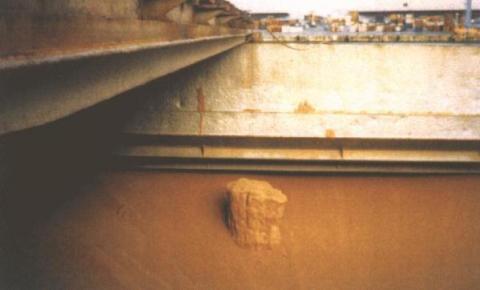
A small column of wetted maize.
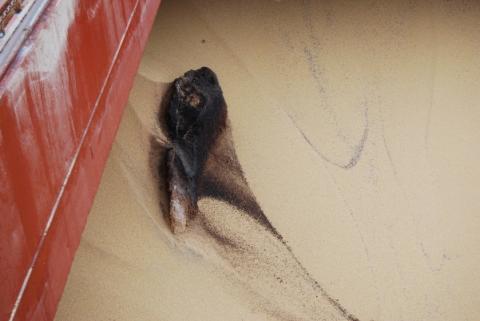
A larger and more severely affected region.
Water ingress from ballast tanks or bilge wells generally results in wetted cargo in a layer on the tank top. Upward spread of damage from this is rare.
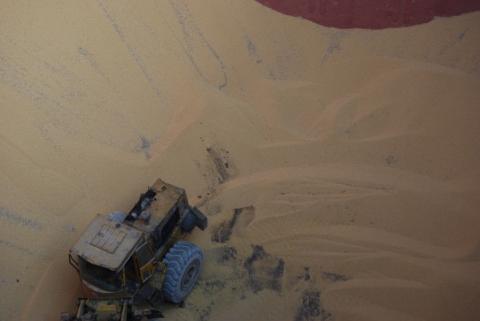
A layer of cargo wetted by water ingress at the bottom of a hold.
Condensation/sweat
The characteristic pattern of wetting by sweat is that damage is concentrated under the steel structures making up the undersides of hatch coaming, hatch covers, frames and so on. Wetting and damage penetrates only a few centimetres below the surface of the stow.
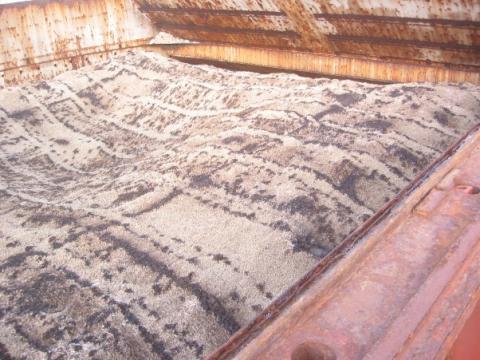
Characteristic patterns of wetting by condensation/ship’s sweat.
Self-heating and moisture migration
What is often found is a pattern of heating and caking which gradually reduces in severity towards the lower regions of the stow. Moisture driven upwards can cause heavy deterioration near to the stow surface.
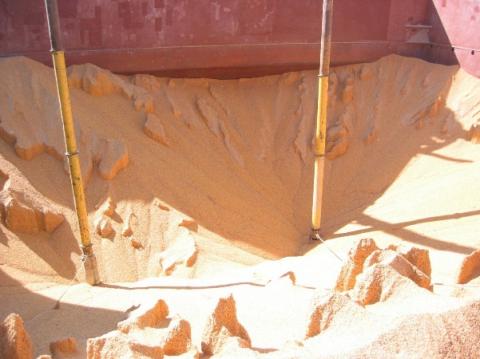
Self heating within a bulk stow causes generalised caking and discolouration
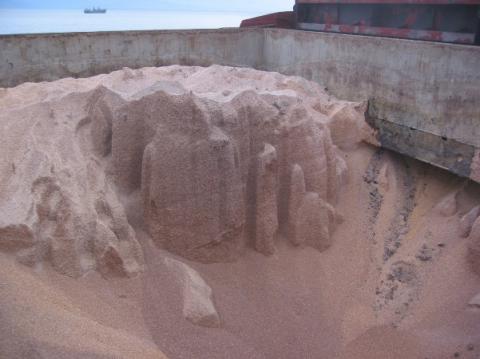
Moisture is driven upwards and outwards and causes heavier damage at the stow peripheries (moisture migration).
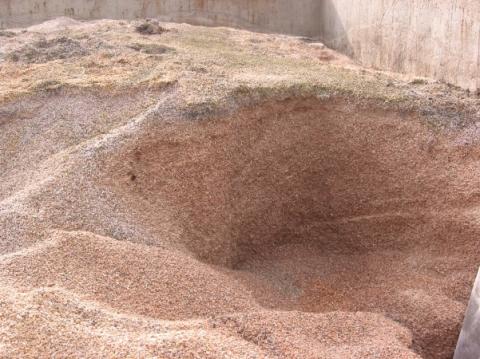
Moisture is driven upwards and outwards and causes heavier damage at the stow peripheries (moisture migration).
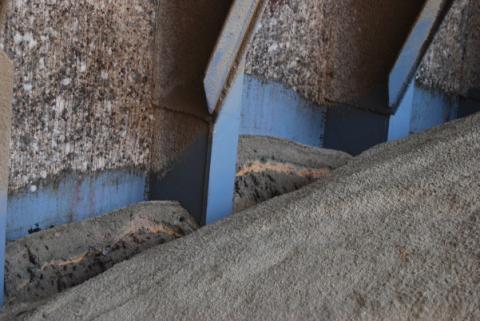
Cool external conditions can also cause moisture to migrate, but the extent is limited.
External heat transfer
This mechanism generally results in a layer or region of discoloured or blackened cargo adjacent to the source of heat. Moisture migration away from this layer can occur but is usually limited in extent.
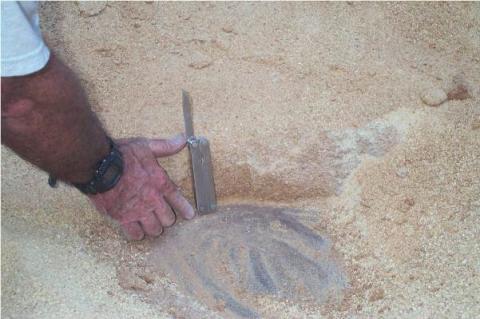
Caking and discolouration caused by heat transfer from a fuel tank.
With thanks to Daniel Sheard of Brookes Bell for preparing this article.

